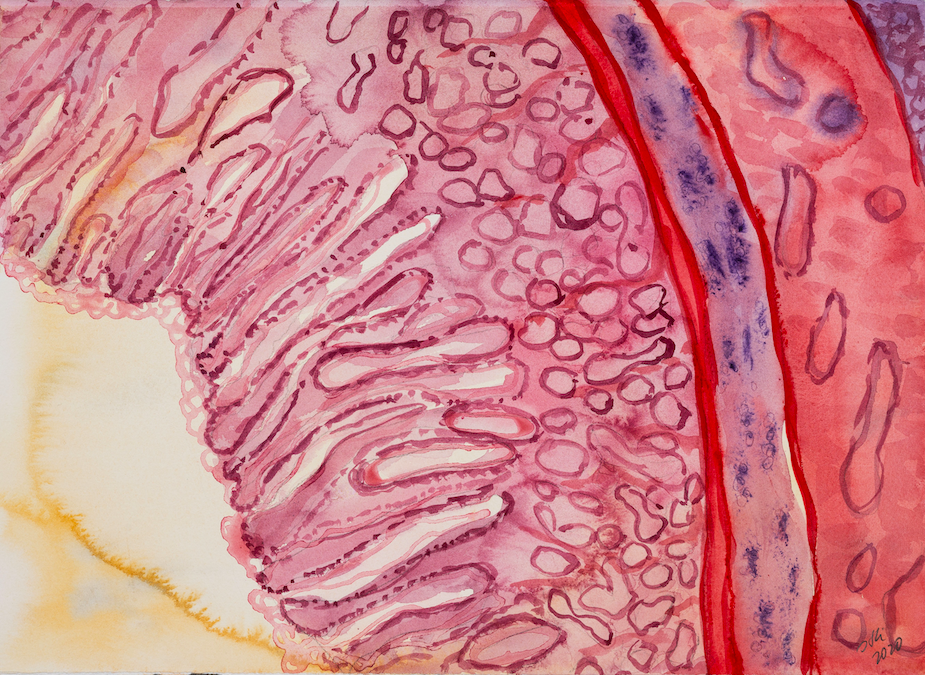Intestinal cells

Biorelevant culture of intestinal cells on Biolaminin substrates
Laminin expression in the intestine
The small intestine contains mucosal epithelial invaginations called crypts of Lieberkühn that are continuous with evaginations into the lumen called villi. The intestinal epithelia are self-renewed by a population of intestinal stem cells within the intestinal crypt that gives rise to progenitor cells, which can subsequently differentiate into mature cell types. The intestinal epithelium is in direct contact with a basement membrane. All laminin a-chains (laminin 111, 211, 332, 411, and 511) are expressed in significant amounts in the small intestine. Importantly, they are distributed in specific patterns along the crypt-villus axis of the intestine and are developmentally regulated (Teller, 2007; Lefebvre, 1999).
Laminin 111 has a vital role in the early developing intestine
The α1 laminin expression is restricted to the intervillous areas in the early developing intestine and is gradually replaced by the α2 laminins as crypts begin to form. The α3 and α5 laminins were both expressed at the base of the intestinal epithelium at the early stages of gut development but tend to be restricted to the villus from mid-gestation onward. The α4 laminins are not expressed in the epithelial basement membrane (Teller, 2007).
Laminin 111 has been identified as a crucial component for organoid formation in intestinal 3D gel models (Gjorevski, 2016). Biolaminin 111 together with the 3D spider silk mesh Biosilk, containing an RGD motif sequence, provides a backbone for intestinal stem cell expansion and organoid culture.
Alpha-5 laminins for maintaining the intestinal architecture
The villus basement membrane is rich in laminin α5 (laminin-511, laminin-521) which is crucial for both establishing and maintaining the small intestinal crypt-villus architecture (Mahoney, 2008; Ritié, 2011). In a publication by Ritié et al., the authors described a mechanistic link between laminin α5 gene deficiency and the physiological phenotype showing that laminin a5 plays a crucial role in both epithelial and mesenchymal cell behavior by regulating Wnt and PI3K signaling (Ritié, 2011). In the absence of laminin α5, the proliferative compartment of the intestine expanded, suggesting a delay in initiating differentiation (Mahoney, 2008). Lack of the laminin α5 chain was accompanied by a decrease in epithelial α3β1 integrin and the Lutheran receptor, indicating that those are likely targets for the laminin α5 laminins (Bolcato-Bellemin, 2003). Enterocytes differentiated normally in the absence of laminin α5 but the terminal differentiation of goblet cells was affected, as shown by the increased numbers of intermediate cells and alteration of mucous granules towards the colon type (Mahoney, 2008). The α5 laminins have also shown a role in intestinal smooth muscle organization and differentiation (Bolcato-Bellemin, 2003).
We recommend Biolaminin 111 for early intestinal specification and Biolaminin 511 for maturation and maintenance.
Succeed with your application
-
Laminin as a Potent Substrate for Large-Scale Expansion of Human Induced Pluripotent Stem Cells in a Closed Cell Expansion System
Gjorevski N. & Lutoff MP. Nat Protoc, 2017
Read more -
Instructions 001: Coating with Biolaminin substrates
Protocol and concentration calculations for coating cultureware with Biolaminin
Open pdf -
Application note 016: Biosilk 3D biomaterial for organoid culture
Features and supporting data for Biosilk in 3D cell culture
Open pdf
Biolaminin Key Advantages
Different laminin isoforms are distributed in specific patterns along the crypt-villus axis of the intestine and are developmentally regulated. The laminin-111 expression is restricted to the intervillous areas in the early developing intestine. The villus basement membrane is rich in laminin α5, crucial for both establishing and maintaining the small intestinal crypt-villus architecture. Laminin α5 plays a crucial role in both epithelial and mesenchymal cell behavior by regulating Wnt and PI3K signaling.
Specific laminin isoforms are present in different tissue microenvironments and are essential for cell survival, proliferation, and differentiation. Biolaminin products allow you to imitate the natural cell-matrix interactions in vitro.
All our matrices are chemically defined and animal origin-free, which makes them ideal substrates for each level of the scientific process – from basic research to clinical applications.
Our products have consistent composition and quality. This enables minimized variability between experiments.
Numerous scientists have found our products and finally succeeded in their specific stem cell application. The power of full-length laminins incorporated into various cell systems is well documented in scientific articles and clinical trials.
Recommended products
-

Biolaminin 111 LN (LN111)
Full-length human recombinant laminin-111
Biolaminin 111 is a full-length laminin-111 protein—an essential extracellular matrix component for many cell types in vivo. It has proven particularly effective in supporting the differentiation of functional hepatic and neural cells in a chemically defined and xeno-free culture.View product -

Biosilk
3D culture substrate
Biosilk is a natural biomaterial made of recombinant spider silk protein, a useful tool for a wide range of 3D culture applications, such as organoid culture and other tissue engineering applications. Biosilk can be mixed with any Biolaminin matrix for cell functionality and identity.View product -

Biolaminin 511 LN (LN511)
Full-length human recombinant laminin-511
Biolaminin 511 is the natural laminin for mouse embryonic stem cells, supporting sustained pluripotency without the need for LIF. It also efficiently promotes the culture of many tissue-specific human cell types.View product -

Biolaminin 521 LN (LN521)
Full-length human recombinant laminin-521
Biolaminin 521 LN is a full-length laminin-521 substrate—the natural laminin for pluripotent stem cells, reliably facilitating ESC and iPSC self-renewal in a chemically defined, xeno-free stem cell culture system. It also uniquely promotes the growth and identity of various tissue-specific human cell types.View product

Talk to our team for customized support
We are here to help you in your journey.